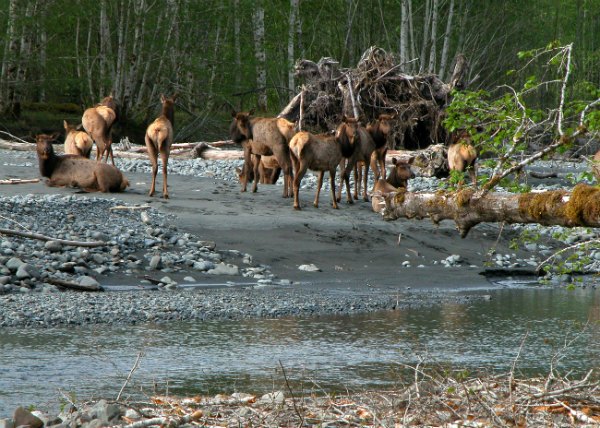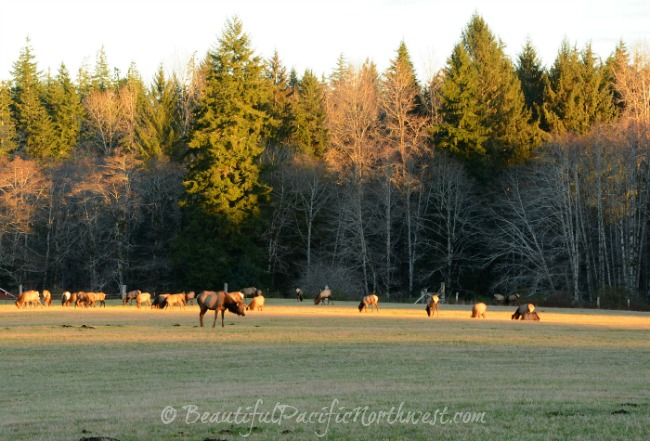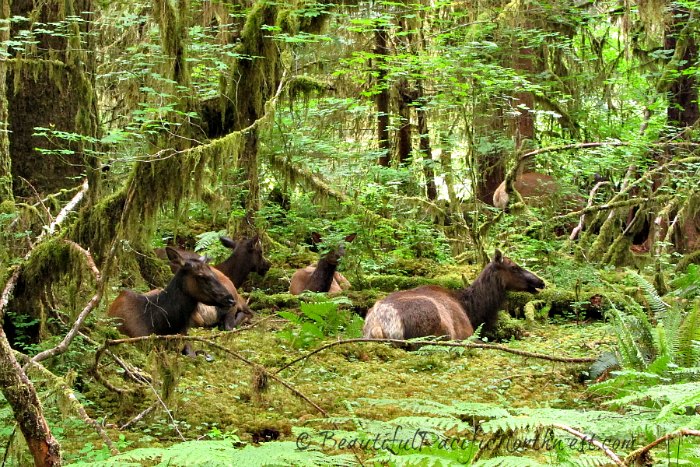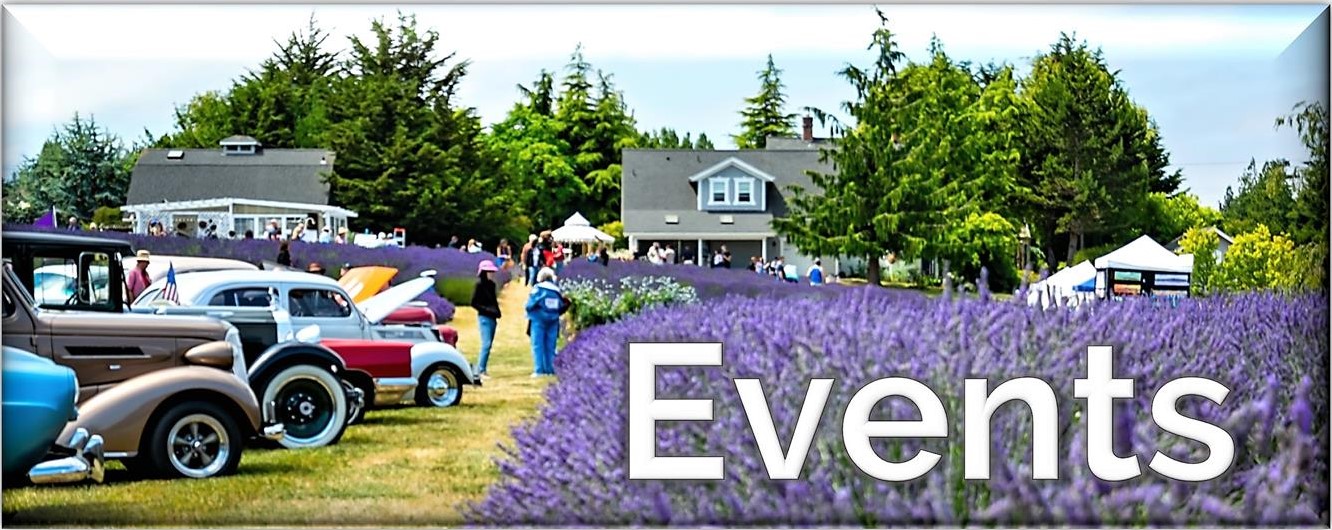Roosevelt Elk
Roosevelt Elk are endemic to Olympic National Park. Learn about their characteristics, habitat, elk in rut, relationships of native Americans to elk, and photos.
The Olympic National Park by itself is home to the largest un-managed herd of Roosevelt elk in North America – roughly 5,000 individuals.
The subspecies of elk known as Cervus Canadensis roosevelti (and sometimes Cervus elaphus roosevelti) were named after President Roosevelt, who traveled to the Olympic Peninsula, and then established the Mount Olympus National Monument in 1909. This National Monument was converted to Olympic National Park in 1938.
In fact, the park’s initial working title was “Elk National Park,” as it was intended that a large national park would protect these once-threatened animals from extinction.
It was a wise move. Numbers of elk, which were plummeting due to overhunting in Roosevelt’s day, have rebounded, and their populations are now stable.
Roosevelt Elk: Physical Traits
Of all the species of elk in the USA, Roosevelt elk are the largest. Elk in general can be found from the Rockies to the Pacific Ocean.
- Genus, species, subspecies: Cervus Canadensis roosevelti
- Size and weight: Adults average 6-10 feet long and up to 5 feet tall at the shoulder. An adult bull might weigh 700 – 1100 pounds, and adult cows might average 575 – 625 pounds.
- Besides being the largest of the elk subspecies, they can be recognized by two other distinctive features. Their heads and necks are very dark, almost black, as compared to other subspecies. The neck fur becomes shaggy and very dark over the winter months. And, the bull’s-eye buff-colored circular patch on their rumps are lighter and more defined.
- Physical: Elk have excellent senses of smell and hearing. When necessary, they can hit 35 mph. 15 years of age is already middle-age for elk. Bulls typically don’t last past 12 years of age, while a cow elk might typically fall to predation by age 16 – 20.
- Calves are born in spring with spots, weighing around 35 pounds. By the time summer has come and gone, so are the spots. They nurse for roughly 9 months. Cows are known to babysit groups of calves so the moms can go get a bite to eat. By fall, they may weigh up to 250 pounds.
- Elk are ruminant herbivore prey animals with digestive systems very similar to that of bovines. They browse the ferns, brush, bushes and brambles of the forest floor, ruminating and redigesting large quantities of low-quality forages. (See Raising-Rabbits.com for more detail on herbivore digestive systems.)
- Elk predators include bears, wolves, mountain lions, man, and sometimes bobcats, coyotes, or your family dog.
- A typical elk herd consists of perhaps 20 or so cows, along with calves, a mature bull, and a few juvenile bull elk. During most of the year, unattached adult bulls live alone or in pairs.
- Only the males grow antlers. Last year’s antlers fall off in the spring between February and late April, and soon begin growing again in preparation for the fall mating season. The antlers are made of bone, covered by a vascular layer of “velvet.” Once the antlers have completed their growth, the velvet dries up, and the elk scrapes off the velvet by rubbing the antlers against trees and brush until they are clean.
See Seattle's Woodland Park Zoo website for complete info on elk physiology and more
Elk Rut
The whole process by which bull elk compete for mating rights is called the rut. It commences in September as bull testosterone levels rise. By then, the antlers have grown to their full magnificence for the year and the velvet has dried and been scraped off.
During the rut, the forest and meadows ring with the clashes of antlers and bugling back and forth between the big bull elk and any challengers to his ownership of the herd of cows. Other bulls, typically already 7-10 years old, fight with the dominant bull, crashing antlers-to-antlers and attempting to drive the opponent backward into insignificance.
Eventually one bull emerges the winner, claiming the “harem” of cows as its own. The new top buck will mate with the cows, guide the herd, and protect it from predators and other bulls.
Roosevelt Elk Habitat
The Olympic Peninsula and surrounding areas of the Pacific Northwest are prime habitat for Roosevelt elk. Populations of elk within the Olympic National Park are steady at roughly 5,000 individuals. Nevertheless, Roosevelt elk can be found as far south as northern California, and north into British Columbia, including a sizable herd on Vancouver Island.
Elk were also transplanted to Afognac and Raspberry Islands in Alaska, where they are doing well.
Although most elk commonly migrate between summer and winter habitats, the river valleys and western slopes of the Olympic mountain range provide consistently excellent forage throughout the year. The large herds of Roosevelt elk within these rainforest environments are non-migratory. Visitors to the Hoh Rainforest are frequently treated to sightings of elk.
Their preferred browse grows mainly in meadows and open spaces: grasses, ground-covering ferns, bushes, berry brambles, mushrooms, lichens, devil’s club, sedges and tree seedlings.
They retreat into the forest during stormy weather. The forest also hides them from predators and hunters, and conceals their calves from danger.
Elk and Native Americans
According to the Washington Department of Fish and Wildlife (WDFW):
“Elk have been an intrinsic part of Washington tribal culture for thousands of years. They have helped Indian people survive throughout the centuries by providing a continual source of meat and marrow for sustenance and vitamins. Elk also have been used for religious purposes, clothing, and drum making. To this day, the elk is part of traditional ceremonies and is essential for maintaining tribal culture” (https://wdfw.wa.gov/living/elk.html).
Elk is still a highly valued asset to the Quileute and other native tribes on the west end of the Olympic Peninsula, as described above. While much of native life today has become modernized, the tribes value and cherish their heritage by keeping the traditional art and ceremonies alive. For this they continue to utilize much of the elk, such as sinew, fur and teeth for jewelry, art, decoration, and drum-making.
More on the history of roosevelt elk and Olympic National Park
Elk and the Interconnectedness of the Pacific Northwest Environment
Roosevelt elk serve an essential role within the Pacific Northwest ecosystem.
- Elk like meadows and areas that are easy to travel through. So, they browse the ferns, the salmonberry vines and the blackberry brambles, opening up the understory so that they and many other native flora and fauna can thrive.
- Elk create wallows in secluded areas where they feel safe. They wallow in these muddy depressions, coating their fur in mud, which helps to rid them of parasites and protect from flying pests. When these wallows are abandoned, they fill up with water, becoming habitat for frogs and salamanders.
- For millennia, the native Indians participated in nurturing the interconnection of Nature. They created habitat favored by Roosevelt elk, at least partially in order to encourage the elk to remain close at hand for their use.
To do this, the Quileute harvested trees for their homes and canoes from the same designated areas of forest near the Hoh and the Quillayute Rivers. In so doing they created several open meadows and prairies, some being several miles in length and breadth. The elk frequented those meadows, browsing the ferns, brambles and bushes, while the Quileute stalked the elk to obtain food and the other items that the elk carcass provided.
This self-sustaining system has lasted through the ages as it was designed to do, each species relying on other species, taking what they needed and no more, so there would be plenty for following seasons and for the use of one's children's children.
Have You Encountered Temperate Rainforest Wildlife?
Tell Your Story and Share Your Photos With Us!
Tell Your Story and Share Your Photos With Us!
Nature can present us with unexpected, breathtaking, and memorable moments! Do you have a great story or an interesting experience encountering any of the many Temperate Rainforest Wildlife species? We'd love to hear about it! Feel free to share it in the form below. Be as wordy and as descriptive as you like. Include photos as well, if you have them; there is plenty of room for it all on our website.
Just click into the title box below and go from there. When published, you'll have "your own" page on MyPortAngeles which you can share with friends or anyone who asks!
We're happy to ensure professional and amateur photographers get credit for their work. Leave us your name in the form below, and means of contact, website, or FB page info so we can link back to you.








